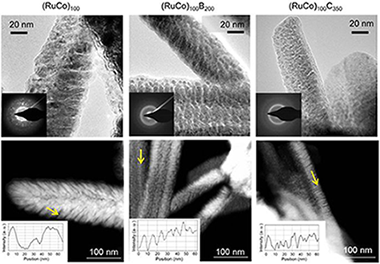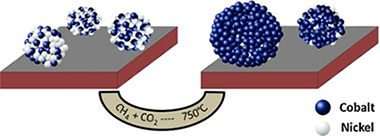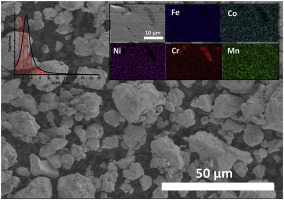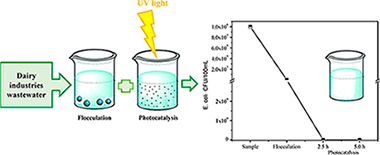Artículos SCI
2018
2018
Materiales Nanoestructurados y Microestructura
Strong activation effect on a ru-co-c thin film catalyst for the hydrolysis of sodium borohydride
Arzac, GM; Paladini, M; Godinho, V; Beltran, AM; de Haro, MCJ; Fernandez, AScientific Reports, 8 (2018) art. 9755
Show abstract ▽

In this work, we prepared a series of Ni foam supported Ru-Co, Ru-Co-B and Ru-Co-C catalysts in the form of columnar thin films by magnetron sputtering for the hydrolysis of sodium borohydride. We studied the activity and durability upon cycling. We found a strong activation effect for the Ru-Co-C sample which was the highest ever reported. This catalyst reached in the second cycle an activity 5 times higher than the initial (maximum activity 9310 ml.min(-1).g(CoRu)(-1) at 25 degrees C). Catalytic studies and characterization of the fresh and used samples permitted to attribute the strong activation effect to the following factors: (i) small column width and amorphous character (ii) the presence of Ru and (iii) dry state before each cycle. The presence of boron in the initial composition is detrimental to the durability. Our studies point out to the idea that after the first cycle the activity is controlled by surface Ru, which is the most active of the two metals. Apart from the activation effect, we found that catalysts deactivated in further cycles. We ascribed this effect to the loss of cobalt in the form of hydroxides, showing that deactivation was controlled by the chemistry of Co, the major surface metal component of the alloy. Alloying with Ru is beneficial for the activity but not for the durability, and this should be improved.
Junio, 2018 | DOI: 10.1038/s41598-018-28032-6
Materiales y Procesos Catalíticos de Interés Ambiental y Energético
Understanding the differences in catalytic performance for hydrogen production of Ni and Co supported on mesoporous SBA-15
Rodriguez-Gomez, A; Pereniguez, R; Caballero, ACatalysts, 307 (2018) 224-230
Show abstract ▽

Three mono and bimetallic NixCo1-x/SBA-15 catalysts (x = 1, 0.5 and 0) with a total metallic content of 10 wt% have been prepared by a deposition-precipitation (DP) method. The catalytic performances on the dry reforming of methane reaction (DRM) have been determined and correlated with their physical and chemical state before and after the catalytic reaction. So, while the nickel monometallic system presents a high activity and stability in the DRM reaction, the Co/SBA-15 catalytic system turns out completely inactive. For its part, the Ni0.5Co0.5/SBA-15 has initially a catalytic performance similar to the Ni/SBA-15 monometallic system, but rapidly evolving to an inactive system, therefore resembling the behavior of the cobalt-based catalyst. The characterization by TEM and in situ XPS techniques has allowed us to ascribe these differences to the initial state of metallic particles after reduction and their different evolution under reaction conditions. So, while after reduction both nickel containing NixCo1-x/SBA-15 catalysts (x = 1 and 0.5) present a well dispersed metallic phase, the cobalt monometallic catalyst yields big metallic particles with a heterogeneous distribution of sizes. Additionally, unlike the Ni/SBA-15, the NiCo/SBA-15 system increases during reaction the metallic particle sizes.
Besides indicating that the particle size is a major reason determining the catalytic performances, these results suggest that in the Ni-Co system both metals form after reduction a bimetallic phase mainly located inside the mesoporous channels of SBA-15 support. Under DRM reaction conditions, the cobalt is segregated to the surface of the bimetallic particles, which seems to determine the interaction with the support surface SBA-15. This feature gives rise to a much less stable metallic phase which suffers an important sintering process under DRM catalytic conditions.
Junio, 2018 | DOI: 10.1016/j.cattod.2017.02.020
Reactividad de Sólidos
Effects of milling time, sintering temperature, Al content on the chemical nature, microhardness and microstructure of mechanochemically synthesized FeCoNiCrMn high entropy alloy
Alcala, MD; Real, C; Fombella, I; Trigo, I; Cordoba, JMJournal of Alloys and Compounds, 749 (2018) 834-843
Show abstract ▽

FeCoNiCrMn(Al)-based powdered high entropy alloys were synthesized by a short time mechanical alloying process in a high energy planetary ball milling from mixtures of elemental powders, and subsequently sintered by a pressureless procedure. The composition and microstructure of the HEA phases before and after the sintering process were studied by X-ray diffraction, energy dispersive X-ray analysis (EDX) and scanning electron microscopy. The microhardness and tensile strength values for Fe1,8Co1,8Ni1,8Cr1,8Mn1,8Al1,0 HEA sintered at 1400 degrees C sample were 3,7 GPa and 1011 MPa, respectively. Statistical Fisher-Pearson coefficient of skewness and kurtosis were played to determine the optimum synthesis milling time. The use of NaCl as additive led on to a reduction of the as-milled grain size. After sintering, SEM study confirmed a segregation of the initial HEA phase directly related to the melting temperature of the elements. Three melting temperature groups were described (Cr, FeCoNi and Mn) and they agree with the observation in the elemental mapping study. The presence of Al favored the segregation of Cr.
Junio, 2018 | DOI: 10.1016/j.jallcom.2018.03.358
Fotocatálisis Heterogénea: Aplicaciones
Study of the effectiveness of the flocculation-photocatalysis in the treatment of wastewater coming from dairy industries
Murcia, J.J., Hernández-Laverde, M., Rojas, Muñoz, E., Navío, J.A., Hidalgo, M.C.Journal of Photochemistry and Photobiology A: Chemistry, 358 (2018) 256-264
Show abstract ▽

The aim of the present work was to evaluate the effectiveness of flocculation-photocatalysis as combined processes in the treatment of dairy industries wastewater. Different commercial and lab prepared flocculants and photocatalysts were evaluated. All the materials prepared were extensively characterized. Commercial materials presented the best physicochemical properties and performance in the treatment of the studied wastewater. On one hand, all the photocatalysts evaluated showed bactericidal activity for E. Coli, total coliforms and other enterobacteriaceae. Total elimination of E. coli was obtained by using commercial TiO2 P25 Evonik, under 120 W/m2 of UV–vis light intensity and 5 h of total illumination time. Other species of bacteria remained after treatment under these conditions. It was also found that the highest light intensity of 120 W/m2 led to increase the Chemical Oxygen Demand and Total Organic Carbon in the samples treated, it can be due to the faster formation of new organic compounds as intermediaries during the photocatalytic reactions at the highest photonic flux. Flocculation pre-treatment of the wastewater samples led to improve the effectiveness of the photocatalytic treatment; thus, the combination of flocculation-photocatalysis treatments at low light intensity of 30 W/m2 leads to achieve the total elimination of E. coli, and under this intensity the elimination of total coliforms and other enterobacteriaceae increased 5.48% compared to the photocatalytic treatment alone. These treatment conditions led to comply the Colombian regulations for dairy wastewater.
Mayo, 2018 | DOI: 10.1016/j.jphotochem.2018.03.034
Reactividad de Sólidos
Influence of the Mn content on the TiNbxMn alloys with a novel fcc structure
Chicardi, E; Aguilar, C; Sayagues, MJ; Garcia-Garrido, CJournal of Alloys and Compounds, 746 (2018) 601-610
Show abstract ▽

This work studies the structural evolution of TiNbxMn alloys (x: 0-12 wt%) synthetized by mechanical alloying in a planetary ball mill with different milling times between 1 h and 120 h. The specimens were characterized by X-ray diffraction patterns, scanning and transmission electron microscopies and Energy-dispersive X-ray spectroscopy. It was observed an evolution of the alloys developed from the raw Ti, Nb and Mn elements to bcc-TiNbxMn alloys and, finally, novel fcc-TiNbxMn alloys, with Fm3m space group symmetry, not previously observed. The presence of Mn promotes other interesting effects: a) the decreasing of the crystallite and the particle sizes, reaching values close to 4 nm and 400 nm, respectively, b) the partial amorphization of the fcc-TiNbxMn alloys due to the combined effect of the Mechanical Alloying and the difference of Mn atomic size in comparison with Ti and Nb and c) the presence of Mn that decreases the Fe amount (from milling media) in the as-milled powders.
Mayo, 2018 | DOI: 10.1016/j.jallcom.2018.02.306
- ‹ anterior
- 164 of 420
- siguiente ›














